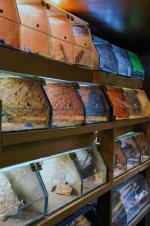sciteacher
New member
Anyone care to share their special techniques for capturing / transferring / photographing, etc... their tiny and ultra-fast geckos species? I've got some Rhoptropus that I swear just teleport themselves from one spot to another. It wouldn't be so bad if they were strictly terrestrial, but they can move vertically and laterally on glass just as fast as they move on the ground. It makes me nervous every time I have to open a lid or door on their cage. I was trying to retrieve some eggs recently and one got out of the cage faster than I could remove my hand and close the door. Luckily it trapped itself in a "dead end" corner and I was able to get a deli cup over it, but I couldn't imagine chasing it down if it had gotten to the more cluttered area of the room where I have boxes, supplies, etc...
I've got some other small, quick species too, and would love to hear if anyone has any techniques that have worked well for them to safely catch and transfer these quick geckos without risking them getting out and leading me on a merry chase. I actually woke up in a sweat last night from a dream that one had gotten out and I was trying to catch it. :yikes: So, share your tips and lower my stress level LOL.
Gary
I've got some other small, quick species too, and would love to hear if anyone has any techniques that have worked well for them to safely catch and transfer these quick geckos without risking them getting out and leading me on a merry chase. I actually woke up in a sweat last night from a dream that one had gotten out and I was trying to catch it. :yikes: So, share your tips and lower my stress level LOL.
Gary



